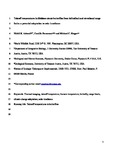Takeoff temperatures in Melitaea cinxia butterflies from latitudinal and elevational range limits: a potential adaptation to solar irradiance
| dc.contributor.author | Parmesan, Camille | |
| dc.contributor.author | Singer, Michael | |
| dc.contributor.author | advani, N | |
| dc.date.accessioned | 2019-03-04T07:45:33Z | |
| dc.date.issued | 2019-01-22 | |
| dc.identifier.issn | 0307-6946 | |
| dc.identifier.issn | 1365-2311 | |
| dc.identifier.uri | http://hdl.handle.net/10026.1/13386 | |
| dc.description.abstract |
1. This study provides evidence that a heliophilic butterfly, the Glanville fritillary (Melitaea cinxia) has adapted differently to environmental variation across latitudes and elevations. 2. In cool air, basking M. cinxia orient themselves perpendicular to the sun's rays to gain heat and take off. During flight, solar heating is reduced because orientation perpendicular to the sun is no longer possible and convective cooling occurs. Consequently, M. cinxia have been shown to suffer net heat loss in flight, even in full sunshine. When flight duration is restricted in this way, the takeoff temperature becomes an important thermal adaptation. 3. Using a thermal imaging camera, takeoff temperatures were measured in experimental butterflies. Butterflies from the northern range limit in Finland took flight at slightly hotter temperatures than butterflies from the southern limit in Spain, and much hotter than butterflies from the elevational limit (1900–2300 m) in the French Alps. Butterflies from low-elevation populations in southern France also took off much hotter than did the nearby Alpine population. 4. These results suggest that the influence of elevation is different from that of latitude in more respects than ambient temperature. Values of solar irradiance in the butterflies' flight season in each region show that insects from the coolest habitats, Finland and the Alps, experienced similar solar irradiance during basking, but that Finns experienced much lower irradiance in flight. This difference may have favored Finnish butterflies evolving higher takeoff temperatures than Alpine butterflies that also flew in cool air but benefited from more intense radiant energy after takeoff. | |
| dc.format.extent | 389-396 | |
| dc.language | en | |
| dc.language.iso | en | |
| dc.publisher | Wiley | |
| dc.subject | Butterfly | |
| dc.subject | climate change adaptation | |
| dc.subject | range limits | |
| dc.subject | solar irradiance | |
| dc.subject | takeoff temperature | |
| dc.subject | thermal imaging | |
| dc.subject | thoracic temperature | |
| dc.title | Takeoff temperatures in Melitaea cinxia butterflies from latitudinal and elevational range limits: a potential adaptation to solar irradiance | |
| dc.type | journal-article | |
| dc.type | Journal Article | |
| plymouth.author-url | https://www.webofscience.com/api/gateway?GWVersion=2&SrcApp=PARTNER_APP&SrcAuth=LinksAMR&KeyUT=WOS:000467427900010&DestLinkType=FullRecord&DestApp=ALL_WOS&UsrCustomerID=11bb513d99f797142bcfeffcc58ea008 | |
| plymouth.issue | 3 | |
| plymouth.volume | 44 | |
| plymouth.publication-status | Published | |
| plymouth.journal | Ecological Entomology | |
| dc.identifier.doi | 10.1111/een.12714 | |
| plymouth.organisational-group | /Plymouth | |
| plymouth.organisational-group | /Plymouth/Faculty of Science and Engineering | |
| plymouth.organisational-group | /Plymouth/REF 2021 Researchers by UoA | |
| plymouth.organisational-group | /Plymouth/REF 2021 Researchers by UoA/UoA07 Earth Systems and Environmental Sciences | |
| dcterms.dateAccepted | 2019-01-22 | |
| dc.rights.embargodate | 2020-1-22 | |
| dc.identifier.eissn | 1365-2311 | |
| dc.rights.embargoperiod | Not known | |
| rioxxterms.versionofrecord | 10.1111/een.12714 | |
| rioxxterms.licenseref.uri | http://www.rioxx.net/licenses/all-rights-reserved | |
| rioxxterms.licenseref.startdate | 2019-01-22 | |
| rioxxterms.type | Journal Article/Review |


